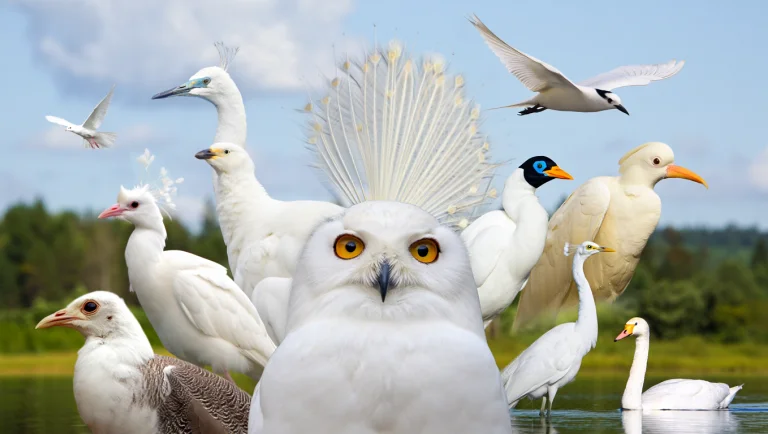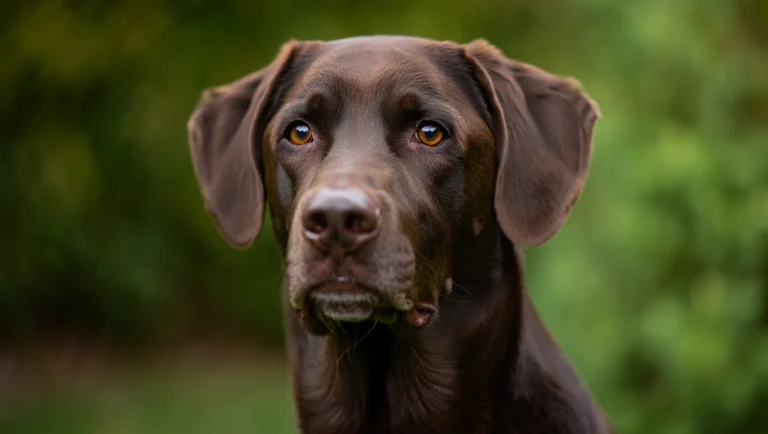Discover the world’s 10 most beautiful white birds with stunning photos and detailed descriptions. From majestic Snowy Owls to elegant White Peacocks, explore these remarkable species.
Table of Contents
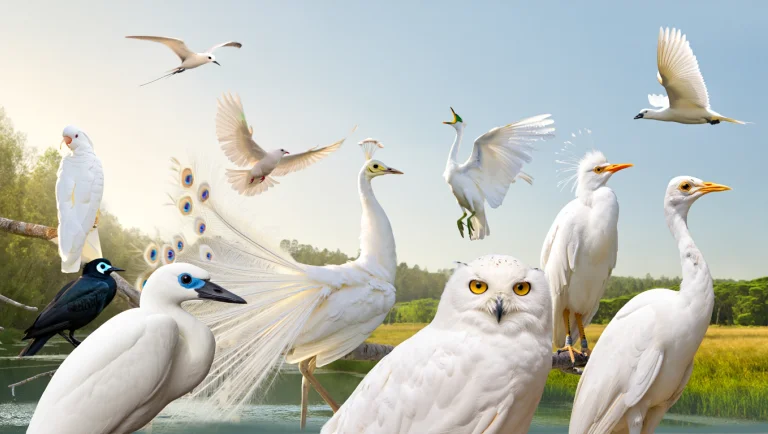
White birds have captivated human imagination for centuries with their pristine plumage, elegant silhouettes, and often symbolic significance. From the snowy landscapes of the Arctic to tropical paradises, these feathered marvels showcase nature’s perfection in its purest form. Their alabaster feathers aren’t just visually striking; they often serve essential evolutionary purposes – providing camouflage in snowy habitats, reflecting heat in warm climates, or signaling to potential mates.
In this comprehensive guide, we’ll explore the most breathtaking white birds from around the world, delving into their unique characteristics, habitats, behaviors, and the conservation challenges many face today. Whether you’re a birding enthusiast, nature photographer, or simply appreciate the beauty of wildlife, this curated collection of magnificent white birds will leave you in awe of nature’s artistry.
1. Snowy Owl (Bubo scandiacus)
Appearance
The Snowy Owl stands as one of nature’s most spectacular white birds, with adult males displaying almost entirely white plumage. Females and younger owls feature distinctive black or dark brown barring across their white feathers. Their round heads lack ear tufts, setting them apart from many other owl species. Perhaps their most mesmerizing feature is their piercing yellow eyes, which create a striking contrast against their snow-white faces.
Habitat and Range
Unlike most owls, Snowy Owls are diurnal (active during daylight hours) and inhabit the Arctic tundra regions of North America, Europe, and Asia. During winter, they often migrate southward when prey becomes scarce in their native breeding grounds. These magnificent birds have been spotted as far south as the northern United States during irruption years when food shortages drive them to travel extraordinary distances.
Behavior and Diet
These powerful predators primarily hunt small mammals, with lemmings constituting up to 90% of their diet in some regions. A single Snowy Owl can consume 3-5 lemmings daily, translating to over 1,600 per year. Their hunting technique involves patient waiting followed by swift, silent attacks from the ground or low perches.
Conservation Status
Currently listed as “Vulnerable” by the IUCN Red List, Snowy Owl populations face threats from climate change, which affects their breeding habitats and prey availability. Recent studies suggest their global population has declined to approximately 28,000 mature individuals, highlighting the growing conservation challenges these iconic white birds face.
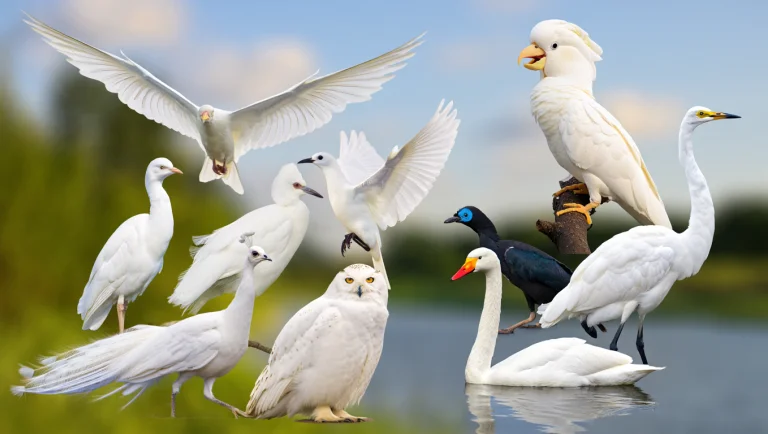
2. Great Egret (Ardea alba)
Appearance
The Great Egret exemplifies elegance with its immaculate white plumage, slender neck, and long, dagger-like yellow bill. During breeding season, delicate ornamental plumes called aigrettes extend from their back, once highly prized in the fashion industry. Standing at nearly 3.3 feet (1 meter) tall with a wingspan reaching 5.5 feet (1.7 meters), these birds present an impressive silhouette against both water and sky.
Habitat and Range
These cosmopolitan white birds inhabit wetlands, marshes, ponds, and shorelines across all continents except Antarctica. They demonstrate remarkable adaptability, thriving in both freshwater and saltwater environments. In North America, their range extends from southern Canada to South America, with year-round populations in warmer southern regions.
Behavior and Diet
Great Egrets employ a patient hunting strategy, standing motionless in shallow water before striking with lightning speed to capture fish, amphibians, and small reptiles. Their hunting success rate is impressive, with studies showing capture rates of up to 60% for targeted prey. They typically nest in colonies called rookeries, often alongside other heron and egret species in tall trees near water bodies.
Conservation Success Story
The Great Egret stands as a conservation success story. Their populations were decimated in the late 19th century when their plumes were harvested for fashion. This devastation helped spark the conservation movement and the formation of organizations like the Audubon Society. Today, their numbers have rebounded significantly, though wetland habitat loss remains an ongoing concern.
3. White Peacock (Pavo cristatus var. alba)
Appearance
The White Peacock isn’t a separate species but a leucistic variant of the Indian Blue Peacock. Unlike albino animals, they possess dark eyes rather than red ones, as they can produce some melanin. Their exceptional beauty lies in the stunning contrast between their immaculate white plumage and the intricate pattern of their tail feathers, which remains visible through subtle differences in texture and iridescence despite lacking pigmentation.
Genetic Background
This breathtaking color morph results from a genetic condition called leucism, which causes partial loss of pigmentation. White peacocks are born white and remain so throughout their lives, unlike standard peacocks that develop their vibrant colors as they mature. When a white peacock displays its magnificent train during courtship, the feather pattern is still visible through subtle variations in the feather structure.
Habitat and Care
White peacocks are primarily kept in ornamental collections, botanical gardens, and estates worldwide due to their striking appearance. They require similar care to standard peacocks, including spacious enclosures, perching options, and protection from predators. In captivity, they typically live 15-20 years when properly cared for.
Cultural Significance
Throughout history, white peacocks have held special significance in various cultures. In Buddhism, they symbolize purity and compassion, while in Christianity, they represent immortality and resurrection. Their rarity and ethereal beauty have made them popular subjects in art, literature, and mythology across civilizations.
4. Mute Swan (Cygnus olor)
Appearance
The Mute Swan embodies grace and elegance with its pure white plumage, long curved neck, and distinctive orange bill marked with a prominent black knob at the base. Adults typically weigh between 20-30 pounds (9-14 kg) and possess an impressive wingspan of 7-8 feet (2.1-2.4 meters), making them one of the heaviest flying birds in the world. Their powerful wings produce a characteristic whistling sound during flight, contrary to what their name might suggest.
Habitat and Range
Native to Europe and parts of Asia, Mute Swans have been introduced to North America, Australia, and South Africa. They prefer shallow lakes, slow-flowing rivers, and coastal lagoons with abundant aquatic vegetation. Unlike many migratory waterfowl, established populations often remain year-round in locations where water remains unfrozen during winter.
Behavior and Pair Bonding
Mute Swans form strong, often lifelong pair bonds, with couples frequently engaging in synchronized swimming and the iconic “heart” formation with their necks. They’re fiercely territorial during breeding season, with males (cobs) aggressively defending their nesting areas against intruders. Their nests are massive structures, typically measuring 4-5 feet (1.2-1.5 meters) in diameter.
Conservation and Management
These magnificent white birds have thrived to the point where they’re considered invasive species in some regions, particularly in North America. Their aggressive territorial behavior and voracious appetite for aquatic vegetation can disrupt native ecosystems. Management efforts aim to balance conservation with controlling population growth in non-native habitats. In their native range, pollution, habitat loss, and lead poisoning from ingested fishing weights remain significant threats.
5. White Cockatoo (Cacatua alba)
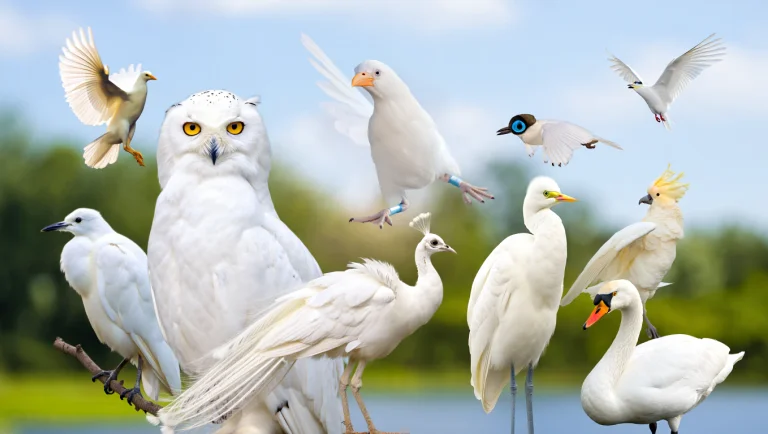
Appearance
The White Cockatoo, also known as the Umbrella Cockatoo, displays stunning pure white plumage complemented by a sulfur-yellow underwing and tail feathers that flash brilliantly during flight. Their most distinctive feature is the dramatic crest of feathers on their head, which they can raise and lower to express various emotional states. Their strong, curved beaks are adapted for cracking nuts and seeds, while their zygodactyl feet (two toes forward, two backward) allow them impressive dexterity.
Habitat and Geographic Distribution
Endemic to the Maluku Islands of Indonesia, these charismatic white birds naturally inhabit lowland forests up to elevations of about 3,000 feet (900 meters). They rely on large, older trees with suitable hollows for nesting sites. In the wild, they typically form small flocks of 10-30 birds that forage together during daylight hours.
Intelligence and Personality
White Cockatoos are renowned for their exceptional intelligence and distinctive personalities. They can learn complex tasks, solve puzzles, and develop vocabularies of up to 100 words and phrases. Their emotional intelligence is equally impressive, with the ability to form deep bonds with caretakers and display a range of emotions from exuberant joy to sensitive empathy. This intelligence demands substantial mental stimulation in captivity to prevent behavioral issues.
Conservation Challenges
Currently listed as “Endangered” on the IUCN Red List, wild White Cockatoo populations have declined precipitously due to illegal trapping for the pet trade and extensive habitat destruction. Wild populations have decreased by over 65% in the last three decades, with current estimates suggesting fewer than 50,000 individuals remain in their native habitat. Conservation efforts focus on habitat protection, breeding programs, and combating illegal wildlife trafficking.
6. White Bellbird (Procnias albus)
Appearance
The male White Bellbird presents a striking contrast with its immaculate snow-white plumage and distinctive wattle – a long, black fleshy appendage that hangs from its beak. This unusual ornament can be retracted or extended during courtship displays. Females, by contrast, display olive-green plumage with streaked underparts, demonstrating remarkable sexual dimorphism. Males measure approximately 11 inches (28 cm) in length, with their wattle potentially extending another 4 inches (10 cm).
Record-Breaking Call
What truly distinguishes the White Bellbird is its extraordinary vocalization – officially the loudest recorded bird call in the world. The male’s distinctive “bonk” call reaches an astonishing 125 decibels, comparable to a jackhammer or thunder crack. Scientists have measured these calls at more than three times the volume of the next loudest bird, the Screaming Piha. During courtship, males often deliver this ear-splitting call directly at potential mates from just feet away.
Habitat and Distribution
These remarkable white birds inhabit the montane forests of northeastern South America, primarily in Venezuela, Guyana, and northern Brazil. They prefer elevations between 1,600-7,200 feet (500-2,200 meters), where they typically perch conspicuously at the tops of trees, making their presence known both visually and aurally across considerable distances.
Diet and Ecological Role
Unlike many songbirds, White Bellbirds are predominantly frugivorous, consuming a wide variety of forest fruits. Their preference for fruit makes them important seed dispersers in their ecosystem, contributing to forest regeneration. They’ve been observed consuming fruits nearly a third of their body weight daily, focusing particularly on lipid-rich varieties that provide energy for their extraordinary vocal performances.
7. Bali Myna (Leucopsar rothschildi)
Appearance
The Bali Myna, also known as the Bali Starling, is a vision of avian elegance with its pristine white plumage contrasted dramatically by cobalt-blue skin surrounding each eye and black tips on its wings and tail. A delicate crest of elongated feathers curves gracefully backward from its head, giving it a perpetually windswept appearance. Measuring approximately 10 inches (25 cm) in length, these medium-sized birds possess a distinct charisma that’s made them highly coveted in aviculture.
Endemic Habitat
Among the most geographically restricted of all white birds, the Bali Myna is endemic solely to the island of Bali in Indonesia. Historically, these birds inhabited the dry, deciduous monsoon forests in Bali’s northwest. Today, their last natural stronghold remains within Bali Barat National Park, where they depend on specific habitat features including open woodlands near water sources and particular tree species for nesting.
Vocal Abilities
Despite their modest size, Bali Mynas produce remarkably varied vocalizations, ranging from melodious whistles to complex warbling phrases. They’re known for their ability to mimic sounds in their environment and incorporate these into their natural repertoire. Mated pairs often engage in synchronized duets, with precise coordination between partners suggesting sophisticated communication.
Critical Conservation Status
The Bali Myna holds the unfortunate distinction of being one of the world’s most endangered birds, classified as “Critically Endangered” by the IUCN. Their wild population plummeted to fewer than 10 individuals in the early 1990s due to rampant poaching for the illegal pet trade, where individual birds commanded prices exceeding $2,000. Intensive conservation efforts, including captive breeding and community-based protection programs, have helped increase their numbers to approximately 100 wild individuals today, though their future remains precarious.
8. Royal Spoonbill (Platalea regia)
Appearance
The Royal Spoonbill commands attention with its immaculate white plumage and extraordinary feeding apparatus – a long, black, spoon-shaped bill that gives the species its name. During breeding season, adults develop distinctive plume-like nuptial crests that cascade down their necks, enhancing their regal appearance. Standing approximately 32 inches (80 cm) tall with a wingspan reaching nearly 4 feet (1.2 meters), these birds present an impressive silhouette in their wetland habitats.
Specialized Feeding Technique
What truly distinguishes these white birds is their unique feeding method. The distinctive spatulate bill serves as a specialized tool for a technique called “tactolocation.” They wade methodically through shallow water, sweeping their partially open bills from side to side. When sensory receptors on the bill detect prey, they snap it shut with remarkable precision, capturing small fish, crustaceans, and aquatic insects. High-speed photography has revealed this feeding action occurs in less than 25 milliseconds – faster than the human eye can perceive.
Habitat and Distribution
Royal Spoonbills inhabit wetlands, estuaries, and intertidal mudflats across Australia, New Zealand, and parts of Southeast Asia. They demonstrate remarkable adaptability, utilizing both freshwater and coastal environments, though they generally avoid deep water where their specialized feeding technique would be ineffective. They often form colonies alongside ibises, herons, and cormorants.
Conservation Status
While currently listed as “Least Concern” globally, Royal Spoonbill populations face localized threats from wetland drainage, water pollution, and habitat disturbance. Their specialized feeding requirements make them particularly vulnerable to changes in wetland ecosystems. In New Zealand, where they arrived naturally from Australia in the 1900s, their population remains small but stable at approximately 2,500 individuals, receiving protected status.
9. White Tern (Gygis alba)
Appearance
The White Tern presents an ethereal vision with its entirely white plumage unbroken by any markings, creating an almost ghostly appearance against tropical blue skies. Their large, dark eyes provide striking contrast against their snow-white heads, while their bills range from deep blue at the base to black at the tip. Unlike many seabirds with webbed feet, White Terns possess delicate, partially webbed feet that appear almost dainty compared to their bodies.
Remarkable Nesting Behavior
What truly sets White Terns apart is their extraordinary nesting strategy – or rather, their complete lack of a conventional nest. Unlike virtually all other birds, they lay their single egg directly on bare tree branches, rock ledges, or even human structures, without building any nest structure whatsoever. The egg is carefully positioned in slight depressions or junctions where branches meet to prevent it from rolling off. This seemingly precarious approach has proven remarkably successful, as the parents diligently take turns incubating to prevent predation.
Habitat and Distribution
These enchanting white birds inhabit tropical and subtropical oceanic islands across the Pacific and Indian Oceans, with populations found in Hawaii, the Seychelles, and numerous atolls throughout Polynesia. They demonstrate strong philopatry, returning to their birth islands to breed. While primarily oceanic, they rely on islands with sufficient tree cover for breeding and raising young.
Aerial Prowess and Feeding
White Terns display exceptional aerial agility, with flight patterns often described as “butterfly-like” due to their buoyant, fluttering wing beats. They hunt by plunge-diving from heights of 50-100 feet (15-30 meters), capturing small fish and squid near the ocean’s surface. Research indicates they can travel up to 75 miles (120 kilometers) from breeding colonies on feeding expeditions, navigating with remarkable precision even in challenging weather conditions.
10. White Ibis (Eudocimus albus)
Appearance
The White Ibis presents an elegant silhouette with its immaculate white plumage that contrasts dramatically with its bright red legs, facial skin, and distinctive long, curved bill. Juveniles display brown plumage that gradually transitions to white as they mature. Their wingspan typically reaches 38 inches (96 cm), while their curved bills extend approximately 6 inches (15 cm), perfectly adapted for probing mud and shallow water for prey.
Habitat and Range
These adaptable white birds inhabit coastal marshes, wetlands, mangrove swamps, and increasingly, urban areas throughout the southeastern United States, the Caribbean, and northern South America. Their population centers in Florida, where an estimated 30,000 breeding pairs represent the largest concentration in the United States. Unlike some wetland species with specific habitat requirements, White Ibises demonstrate remarkable adaptability, even colonizing suburban parks and golf courses when natural habitats diminish.
Social Behavior and Communication
White Ibises are highly social birds, typically foraging and nesting in large colonies that can number in the thousands. They communicate through a variety of vocalizations, including grunts, honks, and nasal calls, particularly during breeding displays. Their synchronized group feeding creates spectacular visual displays as hundreds of birds probe simultaneously in shallow water, often forming a slowly advancing line across mudflats.
Ecological Significance
These birds serve as important bioindicators for wetland ecosystem health. Research from the Everglades has demonstrated that changes in White Ibis breeding success and behavior directly correlate with alterations in water levels and prey availability. Their feeding habits – probing soft mud for crustaceans, insects, and small fish – help aerate wetland substrates and control invertebrate populations. Conservation efforts for these charismatic white birds focus on maintaining healthy wetland hydrology and protecting breeding colonies from disturbance.
FAQs About White Birds
Are white birds rare in nature?
White coloration in birds exists along a spectrum of rarity. Some species, like Snowy Owls and White Ibises, naturally display white plumage as their standard coloration. Others, like the White Peacock, represent genetic variants (leucistic or albino individuals) of typically colored species. True albinism, characterized by complete absence of melanin and resulting in red eyes, is quite rare in wild bird populations, occurring in roughly 1 in 20,000 individuals. Leucism, causing partial loss of pigmentation but retaining normal eye color, is more common. Climate and habitat play important roles in the evolution of white plumage, which often provides camouflage advantages in snowy environments.
How do white birds keep their feathers clean?
White birds employ several specialized behaviors and adaptations to maintain their pristine appearance. Most engage in frequent preening, distributing oil from a specialized gland (uropygial or preen gland) near the base of their tail across their feathers. This oil provides waterproofing and contains antimicrobial compounds that help prevent staining and bacterial growth. Many white birds, particularly waterbirds like egrets and swans, engage in bathing rituals several times daily. Some species, like herons, have specialized powder down feathers that continuously disintegrate into a fine powder that helps clean and waterproof their plumage.
Do white birds have any special adaptations for their coloration?
White plumage offers several evolutionary advantages. In Arctic and snowy environments, it provides crucial camouflage for species like Snowy Owls and ptarmigans. For tropical species, white feathers reflect sunlight and heat, helping birds maintain comfortable body temperatures in hot climates. The structural properties of white feathers (which reflect all wavelengths of visible light rather than absorbing them) contribute to this heat management function. Additionally, bright white plumage often serves important social signaling roles during courtship displays, with the brightness and cleanliness of feathers potentially indicating individual health and genetic quality to potential mates.
Are there any completely white parrot species?
No naturally occurring parrot species displays completely white plumage as its standard coloration. The White Cockatoo (Cacatua alba) comes closest with its predominantly white appearance, though it does have yellow undertones to its crest and tail feathers. Albino and leucistic mutations occur in many parrot species, producing individuals with white or mostly white plumage, but these represent genetic variations rather than standard species characteristics. In aviculture, selective breeding has produced consistently white strains of certain species like Budgerigars and Cockatiels, but these are considered color morphs rather than separate species.
How do white birds survive against predators if they’re so visible?
White birds employ various strategies to counter their visibility to predators. For species in snowy environments, like Snowy Owls and Ptarmigans, white plumage actually provides exceptional camouflage. Many white wading birds like egrets and spoonbills compensate for their visibility by feeding and nesting in groups, creating a “many eyes” effect that improves predator detection. Colony nesting, common among white seabirds, provides safety in numbers. Some white birds, particularly those in tropical settings, nest on isolated islands with few natural predators. Additionally, larger white birds like swans use their size and aggressive defense behaviors to deter potential threats.
What’s the difference between albinism and leucism in birds?
Albinism and leucism represent distinct genetic conditions affecting bird pigmentation. Albinism results from a complete absence of melanin production, causing pure white plumage, pink skin, and distinctive red eyes due to visible blood vessels in the iris. This condition affects all feathers uniformly. Leucism, more common in birds, involves partial reduction in multiple types of pigment cells, resulting in white or patchy plumage but normal eye coloration. Unlike albinos, leucistic birds may retain some colored feathers or show patterns in their plumage. Both conditions can create vulnerability to predators and issues with mate recognition, potentially affecting survival and reproduction in wild populations.
Expert Tips for Observing White Birds
For optimal white bird viewing experiences, consider these expert recommendations:
- Lighting matters significantly – Early morning and late afternoon provide the “golden hours” when soft, warm light enhances the appearance of white plumage without creating harsh shadows or overexposure.
- Use appropriate camera settings – When photographing white birds, slightly underexpose your images (by -0.3 to -0.7 stops) to preserve feather detail that might otherwise be lost in bright conditions.
- Research seasonal patterns – Many white birds display seasonal movements or develop special breeding plumage during specific periods. Time your observations accordingly to witness peak behaviors and appearances.
- Respect minimum distances – Maintain at least 100 feet (30 meters) from nesting areas of sensitive species like egrets and ibises, as disturbance can cause parents to abandon nests.
- Consider specialized equipment – For serious bird observation, invest in binoculars with high light-gathering capabilities and cameras with sufficient zoom range to capture details without disturbing your subjects.
For more expert pet care tips and product recommendations, visit BlithePet your trusted source for pet wellness.
Conclusion
White birds represent some of nature’s most spectacular artistic achievements, combining elegance, adaptation, and evolutionary ingenuity. From the thunderous call of the White Bellbird to the tactical precision of the Royal Spoonbill’s feeding technique, these feathered marvels demonstrate remarkable specialization while sharing the common thread of their striking white plumage.
As we’ve explored, white feathers serve diverse purposes across species – providing crucial camouflage for Arctic dwellers, reflecting heat in tropical environments, or attracting mates through pristine visual displays. The conservation challenges many of these species face remind us of our responsibility to preserve the habitats and conditions that allow these magnificent creatures to thrive.
Whether you’re planning your next birding adventure, seeking inspiration for wildlife photography, or simply appreciating the diversity of avian life on our planet, these ten white birds represent some of nature’s most exquisite creations. Their continued presence enriches our world and reminds us of the breathtaking beauty that careful observation of nature reveals.
Have a similar experience with white birds or other spectacular avian species? Share it in the comments below!

